1993 CHEVROLET ASTRO PASSENGER window
[x] Cancel search: windowPage 131 of 345

Downloaded from www.Manualslib.com manuals search engine HTR (Heater): Most of the air comes out near the floor. The rest comes out
from the defroster vents under the windshield and at the front\
side windows.
This is best for cold weather.
VENT The air comes out at the vents on your instrument panel and at your
front side windows. The air conditioner will not run. Adjust t\
he temperature
lever for warmer or cooler air.
BI-LEV NC: With this, outside air comes in through the heater floor vent and
the instrument panel vents.
If you move your temperature control lever
between cold and hot, cooler air will come out of the upper vents while
warmer air comes out of the
floor vent. This setting is useful in cool weather
with bright sunlight.
NORM NC: This setting cools the outside air. If you first used MAX NC, use
NORM NC as soon as the vehicle has cooled down, so outside air will be
going through your vehicle.
MAX NC: This cools the air the fastest. Move the other lever all the \
way to
Cold.
MAX A/C lets in only a little air from the outside. You can use MAX
NC at first when it’s really hot outside and you need to cool off quickly.
When the air conditioning or defrost is on, you may notice a slight increase
or decrease in engine .speed.
Rear Heater
You may have the optional rear heater. The three-speed fan switch is above
the radio. Slide the lever toward
HI for warmer air in the rear area. Move the
switch to
OFF to turn the system off.
~ PO654
3-7
Page 132 of 345

Downloaded from www.Manualslib.com manuals search engine Comfort Contmls & Audio Systems
Rear Air Conditioning
You may have rear air conditioning. The rear air conditioning switch is loca\
ted
above the radio at the top of the instrument panel. Slide the lever toward
HI
for cooler air in the rear area. Slide the lever to OFF to turn the system off.
If your vehicle has rear air conditioning, setting it on LOW may enhance front
NC performance by allowing trapped refrigerant in rear lines to circulate.
The system
will only send cooled air if the front system is on. It can still be
used
to recirculate air, even if the front system is off.
Before using the rear air conditioning, open the windows to cl\
ear the vehicle
of hot air. Close the windows when using the system.
Rear Window Defogger
HATCH REL REAR DEFOG
If your vehicle has this option the rear window will have lines \
running across
the glass. These lines heat your window.
For best results, clear the window of as much snow and ice as possible
before using the rear window defogger.
To turn on the rear window defogger, find the switch marked
Rear Defog on
your instrument panel to the left of the steering column. Press the top of the
switch until the light in the switch comes on, then release it. The rear window
defogger will only work when the ignition is in the
RUN position.
You can turn the defogger
off at any time by pressing the bottom of the
switch. The defogger will shut itself
off after several minutes so that the glass
3-8
Page 133 of 345

Downloaded from www.Manualslib.com manuals search engine does not get too hot. If the window still isn’t clear, turn the defogger on
again.
Scraping the inside of your rear window could cut and damage th-
defogger. Your warranty would not cover this damage.
A*A don’t put
decals there, you might have to scrape them
I
Engine Block Heater
If you use the optional engine block heater before starting yo\
ur engine, your
heating system will produce warmer air faster to heat the pass\
enger
compartment in cold weather. See “Engine Block Heater” in the Index.
Audio Systems
Your Dekoa audio system has been designed to operate easily and give
years of listening pleasure. But you will get the most enjoyment out of it,
if
you acquaint yourself with it first. Find out what your Delco@ system can do
and how
to operate all its controls, to be sure you’re getting the mos\
t out of
the advanced engineering that went into it.
CAUTION
Hearing damage from loud noise is almost undetectable until it is too
late. Your hearing can adapt to higher volumes
of sound. Sound that
seems normal can be loud and harmful to your hearing. Take
’ precautions by adjusting the volume control on your radio to a safe
sound level before hearing adapts to it.
To help avoid hearing loss or damage:
Adjust the volume control to the lowest setting.
Increase volume slowly until you hear comfortably and clearly.
3-9
Page 162 of 345
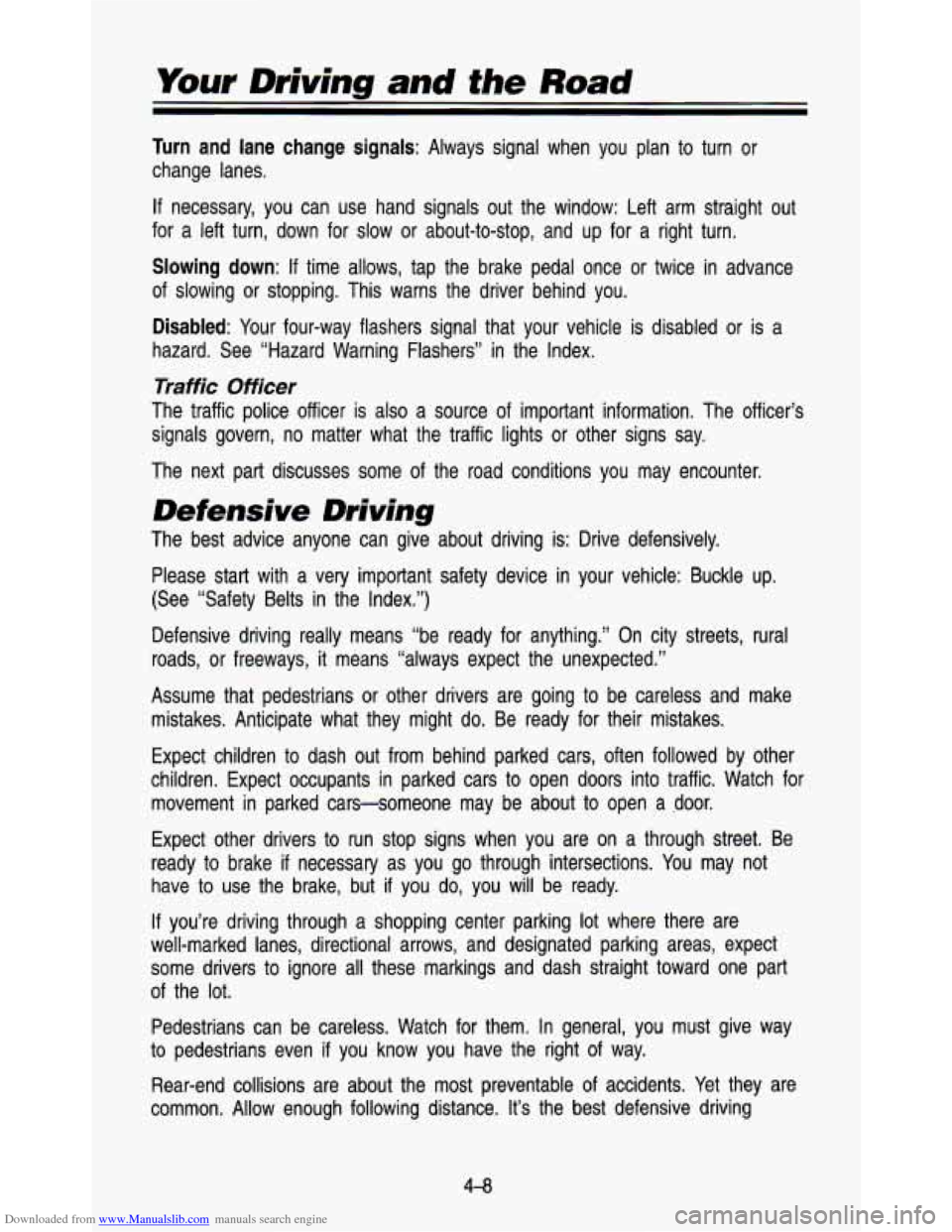
Downloaded from www.Manualslib.com manuals search engine Your Driving and the Road
Turn and lane change signals: Always signal when you plan to turn or
change lanes.
If necessary, you can use hand signals out the window: Left arm \
straight out
for a left turn, down for slow or about-to-stop, and up for \
a right turn.
Slowing down: If time allows, tap the brake pedal once or twice in advance
of slowing or stopping. This warns the driver behind you.
Disabled: Your four-way flashers signal that your vehicle is disabled or is a\
hazard. See “Hazard Warning Flashers” in the Index.
Traffic Officer
The traffic police officer is also a source of important information. The officer’s
signals govern, no matter what the traffic lights or other sig\
ns say.
The next part discusses some of the road conditions you may encounter.
Defensive Driving
The best advice anyone can give about driving is: Drive defens\
ively.
Please start with a very important safety device in your vehic\
le: Buckle up.
(See “Safety Belts in the Index.”)
Defensive driving really means “be ready for anything.’’\
On city streets, rural
roads, or freeways, it means “always expect the unexpected.”
Assume that pedestrians or other drivers are going to be carel\
ess and make mistakes. Anticipate what they might
do. Be ready for their mistakes.
Expect children
to dash out from behind parked cars, often followed by other
children. Expect occupants in parked cars
to open doors into traffic. Watch for
movement in parked cars-someone may be about
to open a door.
Expect other drivers
to run stop signs when you are on a through street. Be
ready to brake if necessary as you go through intersections. You may not
have to use the brake, but
if you do, you will be ready.
If you’re driving through a shopping center parking lot where t\
here are
well-marked lanes, directional arrows, and designated parking are\
as, expect
some drivers to ignore all these markings and dash straight to\
ward one part
of the lot.
Pedestrians can be careless. Watch for them. In general, you m\
ust give way
to pedestrians even
if you know you have the right of way.
Rear-end collisions are about the most preventable of accidents. Yet they are
common. Allow enough following distance.
It’s the best defensive driving
4-0
Page 187 of 345
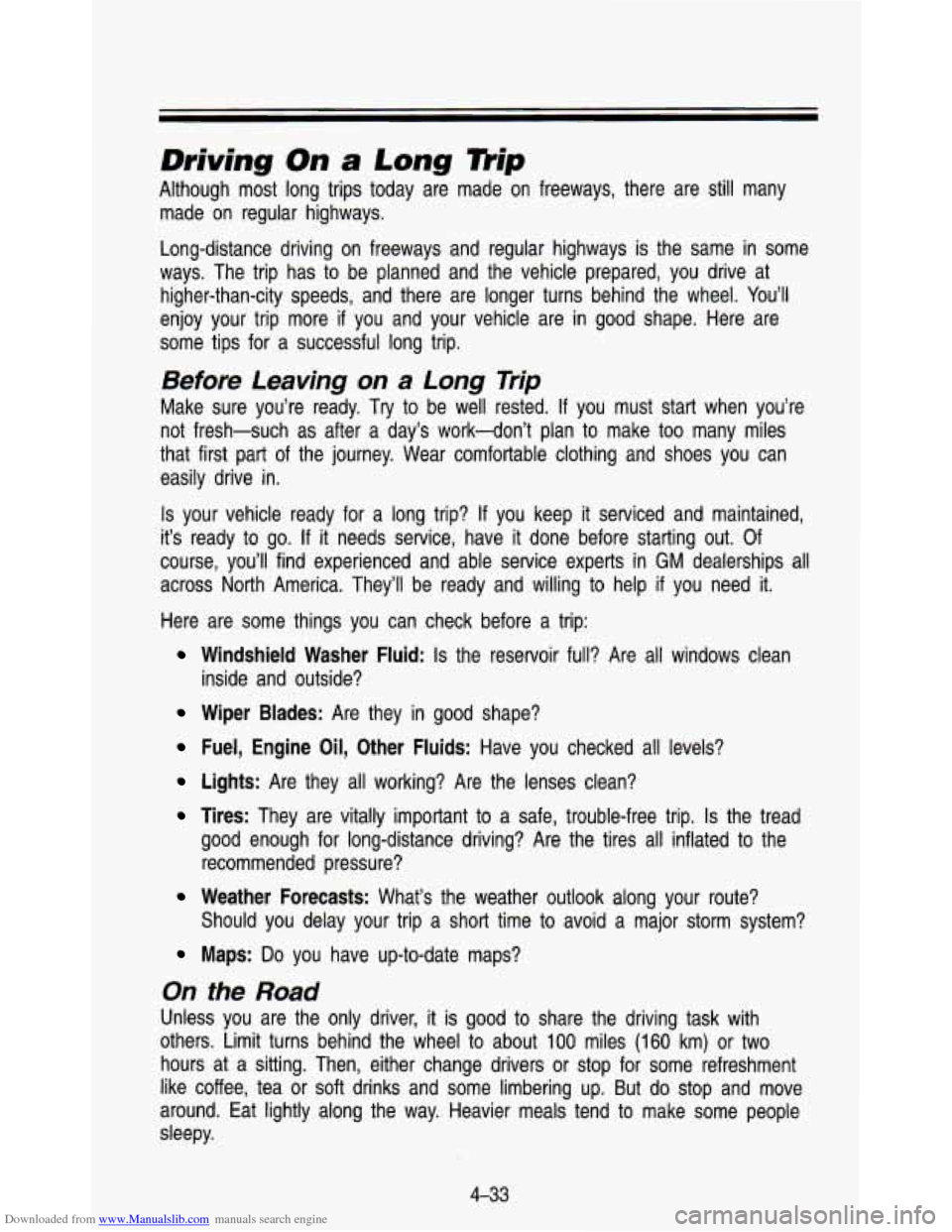
Downloaded from www.Manualslib.com manuals search engine Driving On a Long nip
Although most long trips today are made on freeways, there are still many
made on regular highways.
Long-distance driving on freeways and regular highways is the same in some
ways. The trip has to be planned and the vehicle prepared, you drive at
higher-than-city speeds, and there are longer turns behind the wheel. You’ll
enjoy your trip more
if you and your vehicle are in good shape. Here are
some tips for a successful long trip.
Before Leaving on a Long Trip
Make sure you’re ready. Try to be well rested. If you must start when you’re
not fresh-such as after a day’s work-don’t plan to make too many miles
that first part of the journey. Wear comfortable clothing and shoes you can
easily drive in.
Is your vehicle ready for a long trip? If you keep it serviced and maintained,
it’s ready to
go. If it needs service, have it done before starting out. Of
course, you’ll find experienced and able service experts in
GM dealerships all
across North America. They’ll be ready and willing to help
if you need it.
Here are some things you can check before a trip:
Windshield Washer Fluid: Is the reservoir full? Are all windows clean
Wiper Blades: Are they in good shape?
Fuel, Engine Oil, Other Fluids: Have you checked all levels?
Lights: Are they all working? Are the lenses clean?
Tires: They are vitally important to a safe, trouble-free trip. Is the tread
good enough for long-distance driving? Are the tires all inflated to the
recommended pressure?
Should you delay your trip a short time to avoid a major storm system?
inside and outside?
Weather Forecasts: What’s the weather outlook along your route?
Maps: Do you have up-to-date maps?
On the Road
Unless you
are the only driver, it is good to share the driving task with
others. Limit turns behind the wheel to about
100 miles (160 km) or two
hours- at a sitting. Then, either change drivers or stop for some refres\
hment
like coffee, tea or soft drinks and some limbering up. But
do stop and move
around. Eat lightly along the way. Heavier meals tend to make some people
sleepy.
4-33
Page 197 of 345
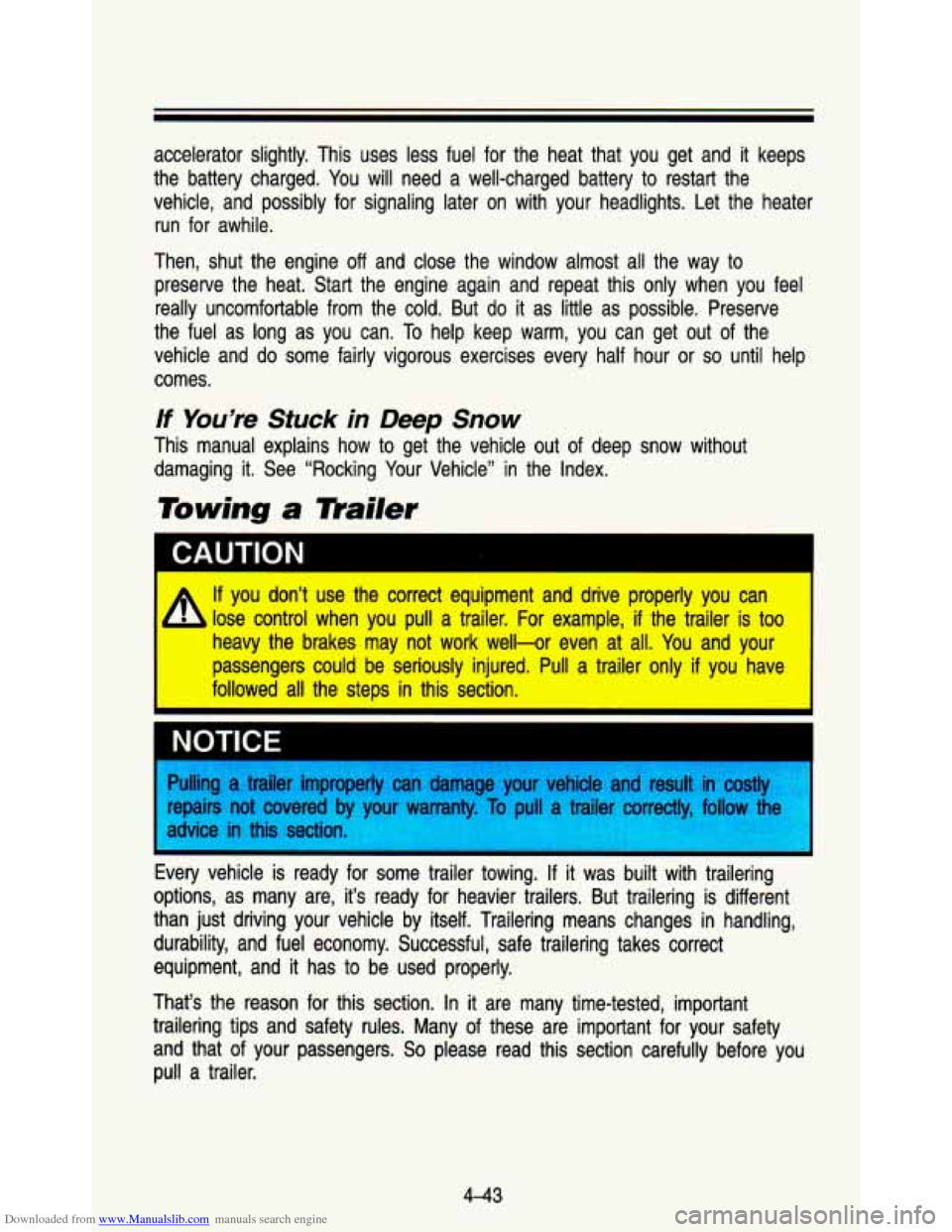
Downloaded from www.Manualslib.com manuals search engine accelerator slightly. This uses less fuel for the heat that yo\
u get and it keeps
the battery charged. You
will need a well-charged battery to restart the
vehicle, and possibly for signaling later on with your headligh\
ts. Let the heater run for awhile.
Then, shut the engine
off and close the window almost all the way to
preserve the heat. Start the engine again and repeat this only\
when you feel really uncomfortable from the cold. But
do it as little as possible. Preserve
the fuel as long as you can. To help keep warm, you ca
vehicle and do some fairly vigorous exercises every half
comes.
If You’re Stuck in Deep Snow
This manual explains how to get the vehicle out of deep
damaging it. See “Rocking Your Vehicle” in the Index.
Towing a mailer
In get out of the
hour or
so until
snow without help
If you don’t use the correct equipment and drive properly you \
can
lose control when you pull a trailer.
For example, if the trailer is too
heavy the brakes may not work well-or even at all. You and your
passengers could be seriously injured. Pull a trailer only
if you have
followed all the steps in this section.
I
NOTICE
Pulling a trailer improperly can damage your vehicle and result\
in costly
advice in this section.
pairs not covered
our
\a/arran+y. To pull a r correct‘ fnllow the
Every vehicle is reaay ior some trailer towing.
If it was built with trailering
options, as many are, it’s ready for heavier trailers. But \
trailering is different
than just driving your vehicle by itself. Trailering means chan\
ges in handling,
durability, and fuel economy. Successful,
safe trailering takes correct
equipment, and it has to be used properly.
That’s the reason for this section. In
it are many time-tested, important
trailering tips and safety rules. Many
of these are important for your safety
and that of your passengers.
So please read this section carefully before you
pull a trailer.
4-43
Page 201 of 345
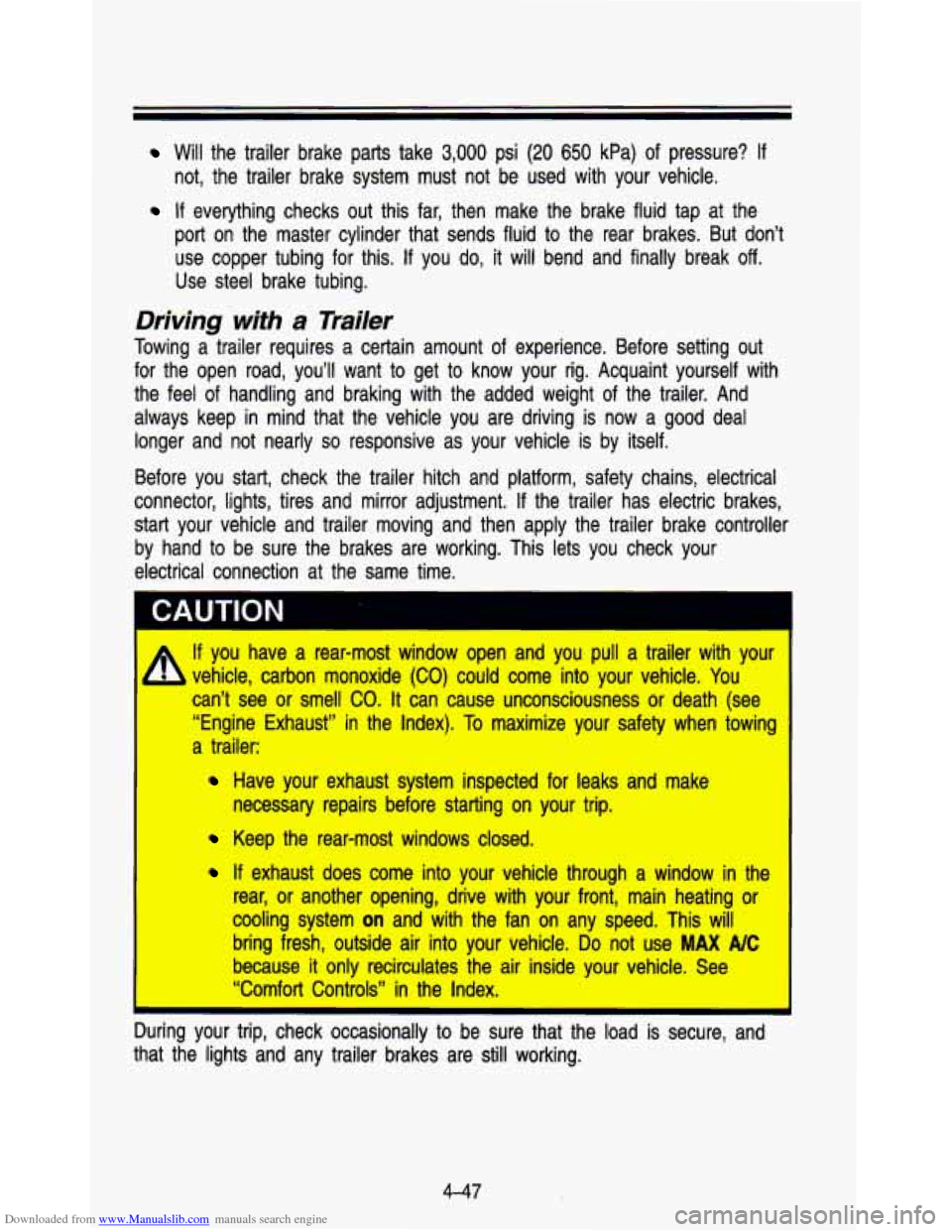
Downloaded from www.Manualslib.com manuals search engine Will the trailer brake parts take 3,000 psi (20 650 kPa) of pressure? If
not, the trailer brake system must not be used with your vehi\
cle.
if everything checks out this far, then make the brake fluid tap at the
port on the master cylinder that sends fluid to the rear brak\
es. But don’t use copper tubing for this.
If you do, it will bend and finally break off.
Use steel brake tubing.
Driving with a Trailer
Towing a trailer requires a certain amount of experience. Before setting out
for the open road, you’ll want to get to know your rig. Acquaint yourself with
the feel of handling and braking with the added weight of the trailer. And
always keep in mind that the vehicle you are driving is now a good deal
longer and not nearly
so responsive as your vehicle is by itself.
Before you start, check the trailer hitch and platform, safety \
chains, electrical
connector, lights, tires and mirror adjustment.
If the trailer has electric brakes,
start your vehicle and trailer moving and then apply the trail\
er brake controller
by hand to be sure the brakes are working. This lets you check your
electrical connection at the same time.
If you have a rear-most window open and you pull a trailer with your
vehicle, carbon monoxide (CO) could come into your vehicle. You
can’t see or smell CO. It can cause unconsciousness or death (see
“Engine Exhaust” in the Index).
To maximize your safety when towing
a trailer:
Have your exhaust system inspected for leaks and make
Keep the rear-most windows closed.
If exhaust does come into your vehicle through a window in the
rear, or another opening, drive with your front, main heating \
or
cooling system
on and with the fan on any speed. This will
bring fresh, outside air into your vehicle.
Do not use MAX NC
because it only recirculates the air inside your vehicle. See
“Comfort Controls” in the Index.
necessary repairs before starting
on your trip.
During your trip, check occasionally to be sure that the load is secure, and
that the lights and any trailer brakes are still working.
4-47
Page 213 of 345
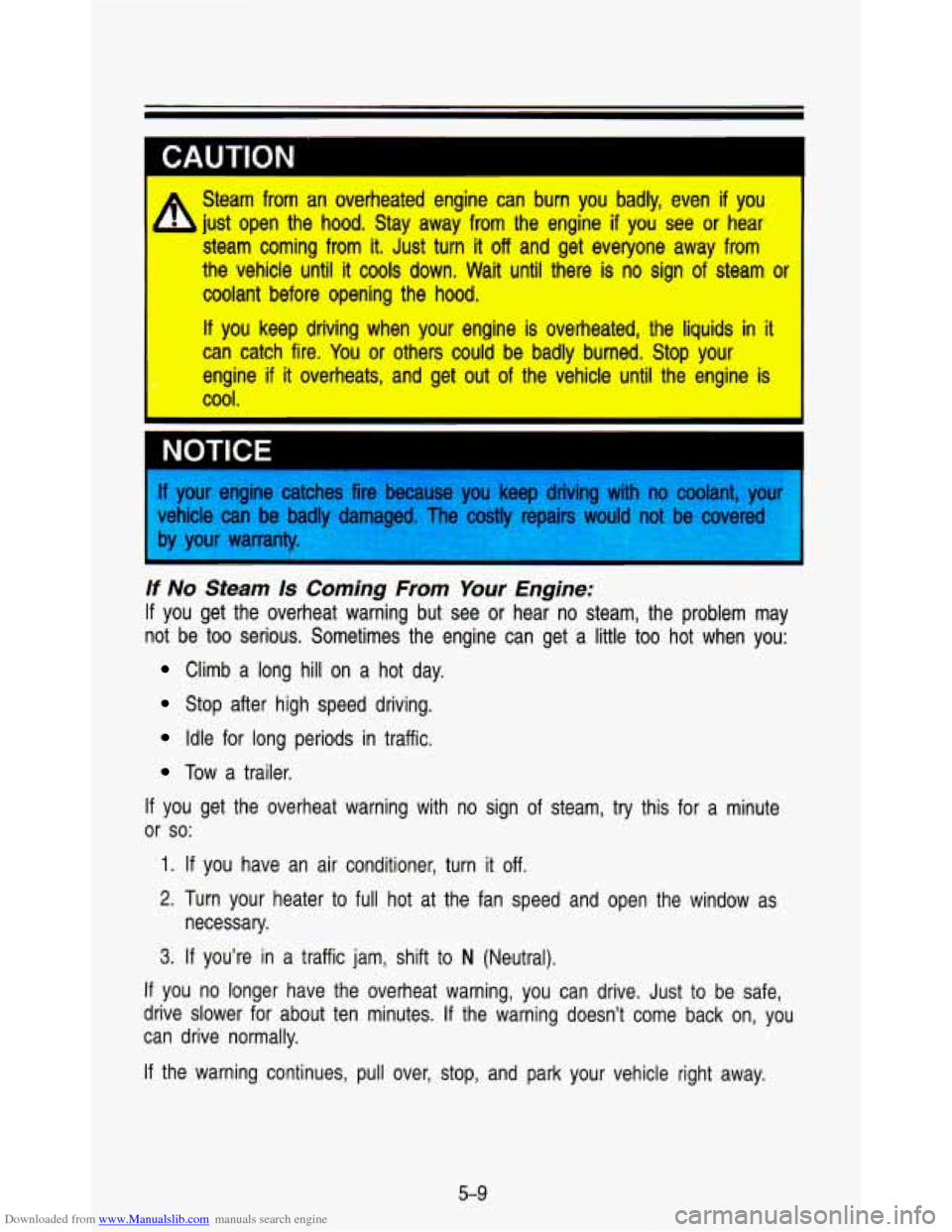
Downloaded from www.Manualslib.com manuals search engine CALITION
I
Steam from an overheated engine can burn you badly, even if you
just open the hood. Stay away from the engine
if you see or hear
steam coming from it. Just turn it
off and get everyone away from
the vehicle until it cools down. Wait until there is no sign of steam
or
coolant before opening the hood.
If you keep driving when your engine is overheated, the liquids in it
can catch fire. You or others could be badly burned. Stop your
engine
if it overheats, and get out of the vehicle until the engine is
cool
m
NOTICE ~~ ~
I your engine catches fire because you keep driving with no coolant, yolrl
lehicle can be badly damaged.
Thrr costly repairs would not be covered
y your warranty.
If No Steam /s Coming From Your Engine:
If you get the overheat warning but see or hear no steam, the problem may
not be
too serious. Sometimes the engine can get a little too hot when you:
Climb a long hill on a hot day.
Stop after high speed driving.
Idle for long periods in traffic.
Tow a trailer.
If you get the overheat warning with no sign of steam, try t\
his for a minute
or
so:
1. If you have an air conditioner, turn it off.
2. Turn your heater to full hot at the fan speed and open the window as
necessary.
3. If you’re in a traffic jam, shift to N (Neutral).
If you no longer have the overheat warning, you can drive. Just to be safe,
drive slower for about ten minutes.
If the warning doesn’t come back on, you
can drive normally.
If the warning continues, pull over, stop, and park your vehicle \
right away.
5-9